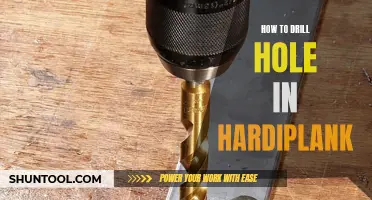
Have you ever found yourself needing to drill dowel holes but realize you don't have a jig? Don't fret! In this article, we will explore the methods and techniques you can use to drill dowel holes without a jig. So grab your drill and let's get started on this woodworking adventure!
What You'll Learn
- Can you drill dowel holes without using a jig?
- What are the alternatives to using a dowel jig for drilling dowel holes?
- Is it possible to drill accurate and precise dowel holes without a jig?
- Are there any specific techniques or tips for drilling dowel holes without a jig?
- What are the potential risks or drawbacks of drilling dowel holes without a jig?

Can you drill dowel holes without using a jig?
Dowel holes are commonly used in woodworking to join pieces of wood together. They provide a strong and reliable connection and can be used in a variety of applications. While using a doweling jig is the recommended method for drilling dowel holes, it is possible to drill dowel holes without using a jig. However, it requires some additional skills and techniques to ensure accurate and precise holes.
Drilling dowel holes without using a jig can be done by following these steps:
- Measure and mark: Start by measuring and marking the locations for the dowel holes on each piece of wood. It is important to ensure that the marks are accurate and aligned properly to ensure a strong joint.
- Use a center punch: To ensure that the drill bit starts in the exact spot where you want the dowel hole, use a center punch to make a small indentation at each mark. This will help to guide the drill bit and prevent it from wandering off course.
- Select the drill bit: Choose a drill bit that matches the size of your dowels. It is important to accurately match the size of the dowel to the drill bit to ensure a tight fit and a strong joint. For example, if you are using 1/2-inch dowels, use a 1/2-inch drill bit.
- Use a brad point drill bit: A brad point drill bit is a good choice for drilling dowel holes without a jig. It has a center point that helps to guide the drill bit and prevent it from wandering. It also has spurs on the sides that help to cut clean and accurate holes.
- Drill the holes: Place the drill bit in the center punch indentation and start drilling the hole. Use a slow and steady motion to ensure accuracy and prevent splintering. It is important to drill straight and perpendicular to the surface to ensure a tight fit between the dowel and the hole.
- Depth control: To ensure that the dowels fit snugly into the holes, it is important to drill the holes to the correct depth. Measure the length of the dowel and mark the drill bit accordingly to control the depth. Place a piece of tape on the drill bit as a visual guide to stop drilling at the desired depth.
- Test fit: After drilling all the dowel holes, test fit the dowels to ensure they fit snugly into the holes. The dowels should fit tightly but not be too difficult to insert. If the dowels are too loose, the joint will be weak and may not hold up over time.
Drilling dowel holes without using a jig requires additional attention to detail and precision. It is important to take your time and follow the steps carefully to ensure accurate and precise holes. Using a brad point drill bit and controlling the depth of the holes are crucial for a strong and reliable joint. Remember to always test fit the dowels before applying any glue or assembly to ensure a proper fit.
How to Recharge a Li-ion Drill Battery Without a Charger
You may want to see also

What are the alternatives to using a dowel jig for drilling dowel holes?
When it comes to drilling dowel holes, a dowel jig is a popular tool that many woodworkers rely on. However, there may be times when a dowel jig is not readily available or suitable for the project at hand. In such cases, there are a few alternatives that can be used to achieve the same result.
One alternative to using a dowel jig is to create a homemade template. This can be done by taking a scrap piece of wood and drilling the desired dowel hole pattern into it. By using various drill bits and spacing them appropriately, a custom template can be created to match the specific needs of the project. This template can then be used as a guide for drilling dowel holes in the workpiece.
Another alternative is to use a drill press with a stop collar. A drill press provides a stable and accurate platform for drilling precise holes. By setting the desired depth and using a stop collar on the drill bit, the depth of the dowel hole can be controlled. Although this method may be more time-consuming and require more setup, it can be a reliable alternative when a dowel jig is not available.
Additionally, a router and a straight edge can be used to create dowel holes. By clamping a straight edge to the workpiece and using a router with an appropriate guide bushing and bit, dowel holes can be accurately cut. This method allows for precise placement of the dowel holes and can be a good alternative when a dowel jig is not accessible.
Alternatively, a drill press vise or a shop-made drilling jig can be utilized. A drill press vise can hold the workpiece securely in place during drilling, ensuring accuracy and precision. Similarly, a shop-made drilling jig can be created by using scrap wood or other materials to create a guide for drilling dowel holes. These alternatives provide stability and control, making them suitable options when a dowel jig is not available.
In conclusion, while a dowel jig is a convenient tool for drilling dowel holes, there are several alternatives that can be used when it is not accessible. By creating a homemade template, using a drill press with a stop collar, utilizing a router with a straight edge, or employing a drill press vise or shop-made drilling jig, accurate and precise dowel holes can still be achieved. It is important to consider the specific needs of the project and choose the alternative that best suits those requirements.
Exploring the Compatibility of Disk Drill: Does It Work on Windows?
You may want to see also

Is it possible to drill accurate and precise dowel holes without a jig?
Dowels are small cylindrical rods that are commonly used in woodworking to join pieces of wood together. They are extremely versatile and can provide a strong and durable connection between two pieces of wood. However, in order for dowels to work effectively, they need to be inserted into accurately drilled holes. This raises the question: is it possible to drill accurate and precise dowel holes without a jig?
While using a jig is the most common method for drilling dowel holes with precision, it is possible to achieve accurate results without one. However, it requires careful planning, attention to detail, and some level of experience.
Here are some steps to follow when drilling dowel holes without a jig:
- Measure and mark: The first step is to measure and mark the exact location where the dowel holes need to be drilled. Use a tape measure and a pencil to make accurate marks on the wood.
- Use a center punch: To ensure that the drill bit doesn't wander off course, use a center punch to create a small indent at the center of each dowel hole mark. This will act as a guide for the drill bit.
- Choose the right drill bit: Select a drill bit that matches the diameter of the dowel you will be using. It is important to choose the correct size to ensure a snug fit.
- Set the drill depth: Adjust the depth of the drill bit to match the length of the dowel. It is crucial to drill just deep enough to accommodate the entire dowel without going too deep.
- Drill slowly and steadily: Place the drill bit on the center punch mark and start drilling slowly and steadily. Apply consistent pressure and avoid pushing too hard, as this can cause the drill to wander.
- Check the depth: Periodically stop drilling and check the depth of the hole. This can be done by inserting the dowel into the hole and measuring how much is left sticking out. Adjust the depth as necessary.
- Clean up the hole: After drilling each hole, use a chisel or a dowel center to clean up any rough edges or burrs inside the hole. This will ensure a smooth and precise fit for the dowel.
While drilling dowel holes without a jig is possible, it is important to note that using a jig will provide more accurate and consistent results. A jig is a specialized tool that guides the drill bit at the exact angle and depth required for the dowel hole. It eliminates human error and ensures a perfect fit every time.
In conclusion, while it is possible to drill accurate and precise dowel holes without a jig, it requires careful planning, attention to detail, and some level of experience. Following the steps outlined above can help achieve good results, but for the highest level of accuracy and consistency, it is recommended to use a jig.
Choosing the Right Drill Bit Size for Lug Nuts: A Comprehensive Guide
You may want to see also

Are there any specific techniques or tips for drilling dowel holes without a jig?
When it comes to woodworking projects, drilling dowel holes is a common task. While using a doweling jig can make the process easier and more precise, it is not always necessary. With the right techniques and tools, you can drill dowel holes without a jig and still achieve accurate results. In this article, we will explore some tips and techniques for drilling dowel holes without a jig.
- Measure and mark: Before starting any drilling, it is essential to measure and mark the location of the dowel holes accurately. Use a ruler or measuring tape to mark the desired distance from the edge of the workpiece. It is recommended to mark both sides of the joint for alignment purposes.
- Choose the right drill bit: Select a drill bit that matches the size of your dowels. The diameter of the drill bit should be slightly smaller than the dowel to ensure a snug fit. For example, if you are using a 1/2-inch dowel, a 7/16-inch drill bit would be appropriate.
- Use a depth stop: To prevent drilling too deep, use a depth stop on your drill. This can be achieved by wrapping a piece of tape around the drill bit at the desired depth. The tape will act as a visual reference, ensuring that you do not drill beyond the required depth.
- Secure the workpiece: It is crucial to secure the workpiece firmly to prevent any movement during drilling. You can use clamps or a vice to hold the workpiece securely in place. This will help maintain accuracy and prevent any accidental slips.
- Practice proper technique: Hold the drill perpendicular to the workpiece and start drilling slowly. Apply consistent pressure and let the drill bit do the work. Avoid excessive force, as it can result in a misaligned hole or even damage the wood.
- Drill test holes: If you are unsure about the accuracy of your markings or technique, it is advisable to drill test holes on scrap wood. This will help you practice and make any necessary adjustments before drilling into your actual workpiece.
- Use a backer board: When drilling through a workpiece, it is common for the drill bit to splinter the wood on the exit side. To prevent this, place a sacrificial backer board beneath the workpiece. The backer board should be made of a softer material, such as plywood, to absorb the drill bit's impact and reduce splintering.
- Check alignment: After drilling the dowel holes, it is essential to check their alignment. Insert a dowel into one hole and align it with the corresponding hole on the adjacent piece. The dowel should fit snugly and be flush with the surface. If needed, adjust the hole by enlarging it slightly to ensure a proper fit.
- Gluing and assembly: Once the dowel holes are drilled and aligned, apply glue to one side of the joint and insert the dowels. Join the pieces together and apply clamping pressure to allow the glue to set. Follow the manufacturer's instructions for the recommended drying time.
Overall, drilling dowel holes without a jig is a feasible task with the right techniques and attention to detail. By measuring and marking accurately, using the appropriate drill bit, and practicing proper drilling technique, you can achieve precise results. Remember to secure your workpiece, drill test holes if needed, and check alignment before gluing and assembling the joint. With practice, you can successfully drill dowel holes without a jig and create strong and accurate woodworking joints.
The Ultimate Guide to Drilling Tapcon Screws into Concrete
You may want to see also

What are the potential risks or drawbacks of drilling dowel holes without a jig?
Drilling dowel holes without a jig can be a tempting shortcut, but it also comes with potential risks and drawbacks. While it may seem like a simple and cost-effective solution, there are several reasons why using a jig is highly recommended.
- Accuracy: One of the main risks of drilling dowel holes without a jig is the lack of accuracy. A jig provides precise measurements and alignment, ensuring that the holes are drilled at the exact location and depth required. Without a jig, it can be challenging to achieve the necessary precision, resulting in misaligned or uneven holes.
- Depth control: Dowel holes need to be drilled to a specific depth to ensure a tight and secure fit. A jig typically includes depth stops that allow for consistent and precise drilling. Without a jig, it can be difficult to control the drilling depth accurately, leading to loose or protruding dowels.
- Angle control: Drilling dowel holes at the correct angle is crucial for proper alignment and structural integrity. A jig provides guides and clamps to ensure accurate drilling at the desired angle. Attempting to drill dowel holes without a jig increases the risk of drilling at incorrect angles, which may result in weakened joints or compromised stability.
- Repeatable results: When creating multiple dowel joints, using a jig allows for consistent and repeatable results. Each hole will be precisely positioned and drilled to the same depth and angle, promoting uniformity and ensuring a tight fit. Without a jig, it becomes challenging to replicate the same results consistently, leading to variations in joint strength and appearance.
- Safety: Using a jig also enhances safety during the drilling process. The jig's clamps and guides hold the workpiece securely in place, reducing the risk of slips or accidental damage. Without a jig, there is a higher chance of the drill bit shifting or catching on the wood, potentially causing injuries or damaging the workpiece.
- Time and effort: While it may seem faster to drill dowel holes without a jig, it often results in a time-consuming and labor-intensive process. Without the guidance and precision of a jig, drilling holes can be a trial-and-error process that requires extra time for adjustments and corrections. In the long run, using a jig saves time and effort by streamlining the drilling process and producing accurate results.
Example scenario: Imagine you are constructing a bookshelf using dowels to connect the shelves to the sides. Without a jig, you attempt to drill dowel holes by eye, resulting in misalignment and loose joints. As a consequence, the bookshelf lacks stability, and the shelves wobble. Additionally, due to the incorrect angles, the dowels fail to provide adequate support, and the shelves sag over time. These shortcomings could have been avoided by using a simple dowel jig to ensure accurate hole placement, alignment, and depth control.
In conclusion, the potential risks and drawbacks of drilling dowel holes without a jig include a lack of accuracy, depth and angle control, inconsistent results, compromised safety, and increased time and effort. Using a jig is essential for achieving precise and reliable results, promoting structural integrity, and enhancing overall project quality. Investing in a jig is a worthwhile decision for anyone working with dowel joints.
The Compensation of Drill Sergeants: A Comprehensive Guide
You may want to see also
Frequently asked questions
Yes, it is possible to drill dowel holes without a jig. While using a jig can help ensure accuracy and consistency, you can still drill dowel holes by carefully measuring and marking the location for each hole. It may require more attention and precision, but it is definitely doable without a jig.
To drill dowel holes without a jig, you will need a drill, drill bits (specifically sized for your dowels), a measuring tape or ruler, a marking tool (such as a pencil or pen), and a steady hand. It is important to make sure you have the correct drill bit size that matches the diameter of your dowels to ensure a snug fit.
To ensure accuracy when drilling dowel holes without a jig, it is crucial to measure and mark the location for each hole precisely. Use a measuring tape or ruler to determine the distance from the edge of the material where you want to drill the hole. Mark the spot with a pencil or pen and double-check your measurements before drilling. Taking your time and being meticulous will help achieve accurate results.
One tip for drilling dowel holes without a jig is to use a brad point drill bit. This type of drill bit has a sharp center point that helps guide the bit into the material, making it easier to drill accurately. Additionally, clamping the material down securely before drilling can help prevent it from moving or shifting during the drilling process, ensuring better accuracy.
Yes, using a template or guide can be a helpful alternative when drilling dowel holes without a jig. Simply create a template out of a piece of scrap wood or cardboard that has the appropriate hole spacing for your dowels. Place the template on top of the material you want to drill the dowel holes in and use it as a guide for marking and drilling the holes. This can help ensure consistent hole placement and accuracy.







